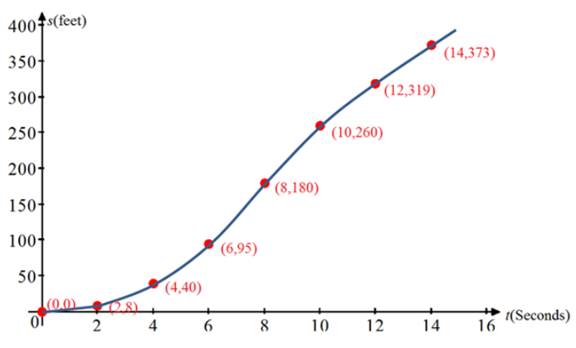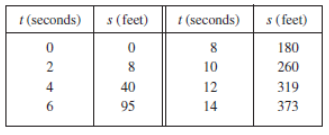
(a)
To find:Thespeed after
(a)
Answer to Problem 47RE
The velocity (speed) after
Explanation of Solution
Given information:
The car starts from rest and its distance traveled is recorded in following table.

Figure (1)
Calculation:
For time period
For time period
For time period
For time period
The slope of the secant line from
The slope of the secant line from
So, the velocity at
Therefore, the velocity (speed) after
(b)
To find:The coordinates of the inflection point of the graph of the position function.
(b)
Answer to Problem 47RE
The coordinates of the inflection point of the graph of the position function is
Explanation of Solution
Given information:
The car starts from rest and its distance traveled is recorded in following table.

Figure (1)
Calculation:
The graph for the position function

Figure (1)
From the graph observed that,
The curve is concave upward on an interval
The curve is concave downward on an interval
The curve changed from concave upward to concave downward at approximately the point
The inflection point is a point where a curve changes its direction concavity.
Therefore, the coordinates of the inflection point of the graph of the position function is
(c)
To find:The significance of the inflection point.
(c)
Answer to Problem 47RE
The significance of
Explanation of Solution
Given information:
The car starts from rest and its distance traveled is recorded in following table.

Figure (1)
Calculation:
Using the slope of the curve as
As the distance approaches its maximum value of about
The rate of change of position function
Therefore, the significance of
Chapter 2 Solutions
Single Variable Calculus: Concepts and Contexts, Enhanced Edition
 Calculus: Early TranscendentalsCalculusISBN:9781285741550Author:James StewartPublisher:Cengage Learning
Calculus: Early TranscendentalsCalculusISBN:9781285741550Author:James StewartPublisher:Cengage Learning Thomas' Calculus (14th Edition)CalculusISBN:9780134438986Author:Joel R. Hass, Christopher E. Heil, Maurice D. WeirPublisher:PEARSON
Thomas' Calculus (14th Edition)CalculusISBN:9780134438986Author:Joel R. Hass, Christopher E. Heil, Maurice D. WeirPublisher:PEARSON Calculus: Early Transcendentals (3rd Edition)CalculusISBN:9780134763644Author:William L. Briggs, Lyle Cochran, Bernard Gillett, Eric SchulzPublisher:PEARSON
Calculus: Early Transcendentals (3rd Edition)CalculusISBN:9780134763644Author:William L. Briggs, Lyle Cochran, Bernard Gillett, Eric SchulzPublisher:PEARSON Calculus: Early TranscendentalsCalculusISBN:9781319050740Author:Jon Rogawski, Colin Adams, Robert FranzosaPublisher:W. H. Freeman
Calculus: Early TranscendentalsCalculusISBN:9781319050740Author:Jon Rogawski, Colin Adams, Robert FranzosaPublisher:W. H. Freeman
 Calculus: Early Transcendental FunctionsCalculusISBN:9781337552516Author:Ron Larson, Bruce H. EdwardsPublisher:Cengage Learning
Calculus: Early Transcendental FunctionsCalculusISBN:9781337552516Author:Ron Larson, Bruce H. EdwardsPublisher:Cengage Learning





